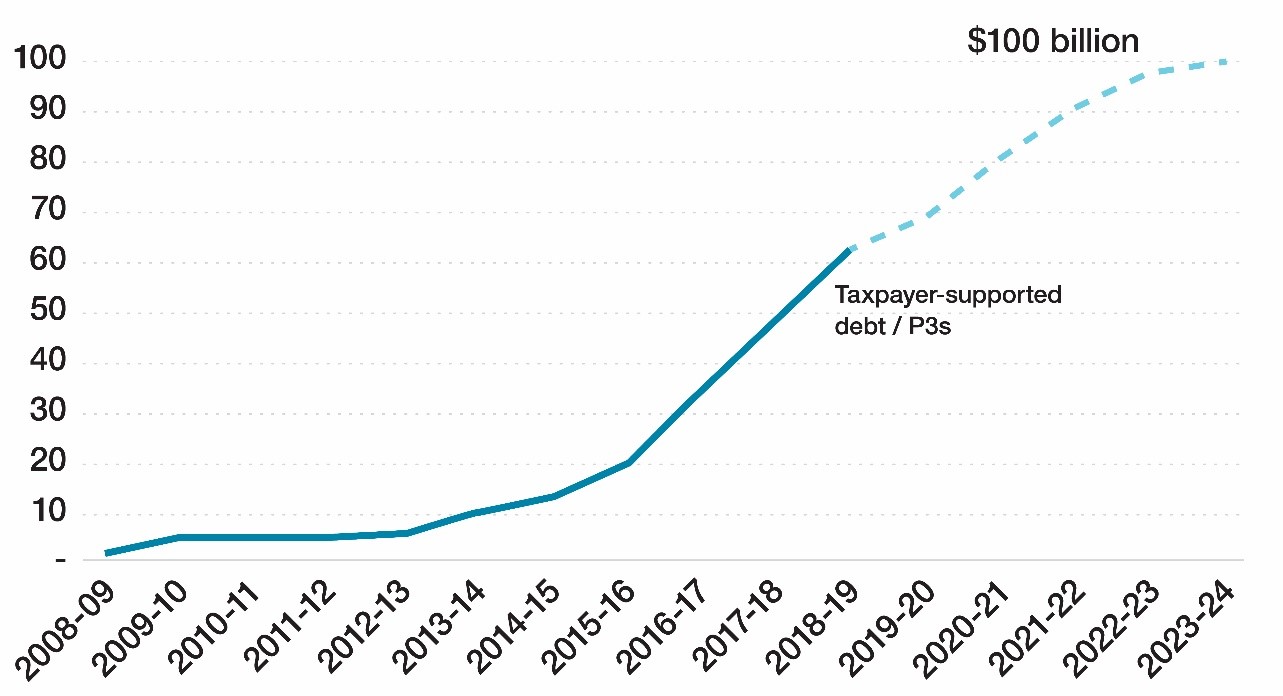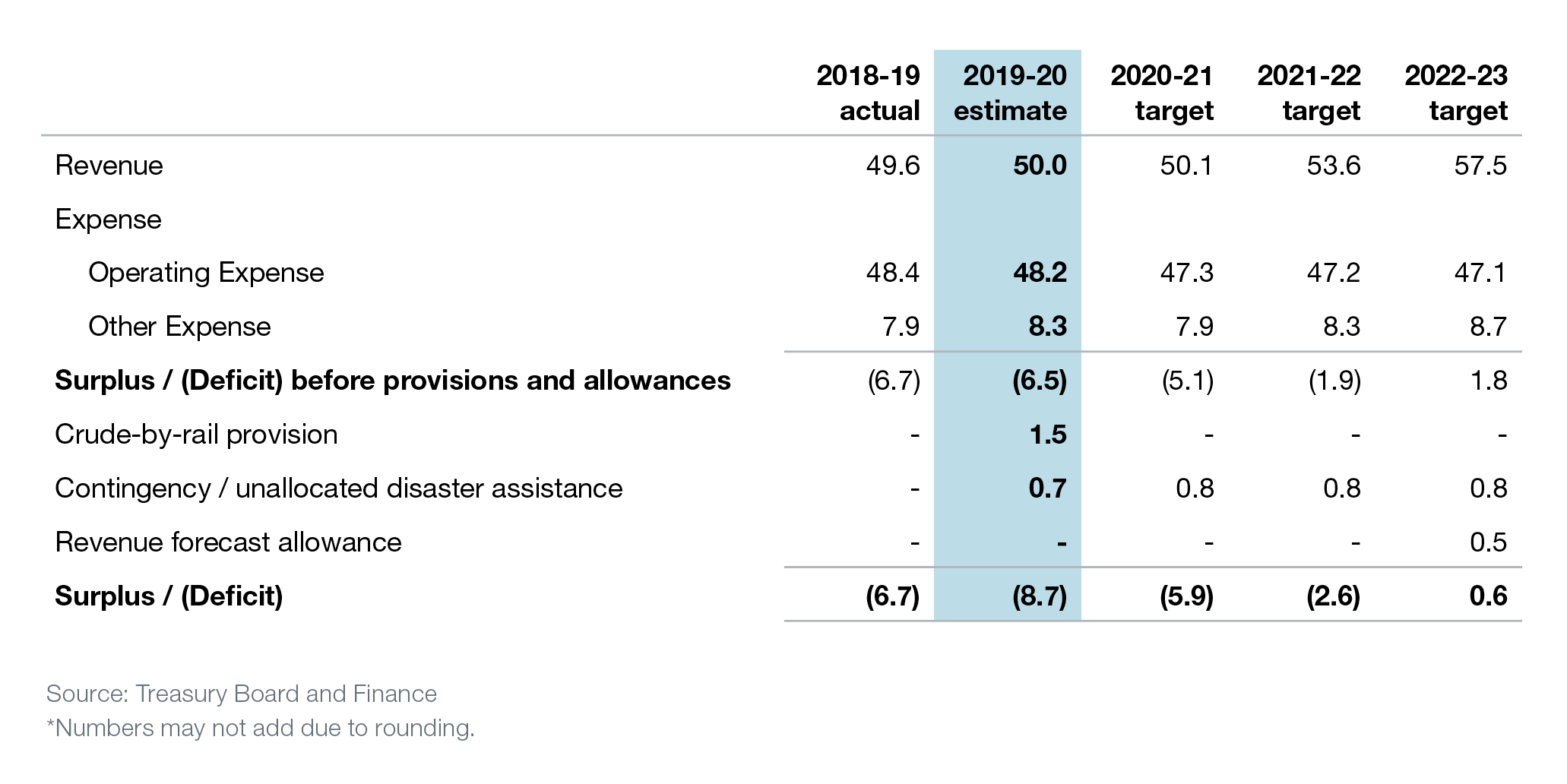CALGARY (660 NEWS) — Cuts and constrained spending will hopefully bring the province back to balance, according to the Alberta Government’s 2019 budget.
The United Conservative Party released its first budget Thursday, and follows up on promises to reduce spending, assist the energy sector and put Albertans back to work.
But as a result of that mission, many Albertans will also be paying more for some services, though the government hopes the plan will still assist lower-income residents, businesses and families.
The recent MacKinnon Panel report plays a major factor in the budget, and coupled with increased projections in the energy sector, revenue should be increased.
With spending going down, the government aims to have a balanced budget by 2023.
Overall, the government will reduce operating costs by 2.8 per cent over the next four years, including shrinking the public sector by 7.7 per cent. These cuts will include “targeted reductions”, mainly through attrition but also involving some layoffs, and are expected to save a total of $552 million.
RELATED: CTF says Alberta overspends more than other provinces
The budget states that growth prospects are high in Alberta, but other external factors and a lack of market access for natural resources will still delay the province’s recovery from the last recession. More specifically, GDP is not expected to return to 2014 levels until 2020 and full employment will not be reached until the end of the budget cycle in 2023.
While the budget is a comprehensive plan for Alberta’s finances, it is also noted that things could change and this is not necessarily set in stone. One factor being relied on to improve the situation is the planned completion of pipeline projects such as the Trans Mountain expansion and Enbridge’s Line 3.
Also, with lots of talk about the debt, taxpayer-supported debt is now forecast to reach $93.3 billion at the end of 2022-23, as opposed to the NDP forecast of $97.1 billion. However, Finance Minister Travis Toews indicated the actual deficit under the NDP would have totalled more than $104 billion.
The government says they have to reel in spending first before real significant reductions are seen in that debt.

TAXES
One crucial component for the United Conservative Party in its 2019 campaign platform and in this budget is reducing taxes for both individuals and corporations.
The UCP says by reducing the corporate tax rate to eight per cent by 2023, there will be an increased investment and higher wages, with the average tax-paying corporation saving about $100,000 per year. Small businesses may also benefit, thanks to the repeal of the carbon tax and small business tax rates being frozen at two per cent.
The Alberta Family Employment Tax Credit and the Alberta Child Benefit will provide eligible families with more cash, amounting to over $5,000 per year to mainly improve the situation for low-income families.
In a mix of tax and health priorities, the government is also boosting the tobacco tax by $5 per carton, and by 3.75 cents per gram of loose tobacco.
These changes, effective Friday, are expected to bring in upwards of $55 million per year.
Also, amid the concerns about vaping and the province launching a review of the tobacco legislation, vaping products will also be taxed in order to restrict youth access. More details are expected in that department in 2020.
FUNDING PRIORITIES

Budget 2019 includes three main priorities: Getting Albertans back to work, making life better for Albertans, and Standing up for Alberta.
The government says this budget maintains or increases funding in core social services, with the aim of reducing costs on low-income Albertans and the most vulnerable.
The repeal of the carbon tax plays a role in that, with the estimation it will save the average family with two children about $665 per year.
Over $20 billion is being provided for health care, including increases of $100 million for mental health and addictions, $40 million for an opioid response, and $20 million for palliative care.
Education will be maintained at $8.2 billion per year but includes some changes to K-12 and post-secondary funding.
Community and social services will see a 7.6 per cent increase in funding, including initiatives tackling human trafficking and sexual exploitation, while children’s services will be boosted by 15 per cent by 2022-23 compared to this past fiscal year.
Also of note, while there will be no specific cuts to Assured Income for the Severely Handicapped (AISH), the Alberta Seniors Benefit, Income Support and Special Needs Assistance programs, indexation of these programs will be paused.
PROMOTING THE ENERGY SECTOR
Pointing out that Alberta’s economy is a major contributor to the Canadian economy as a whole, improving market access for oil and natural gas is a focus of the United Conservative government.
This reaches a broad range of topics including the so-called energy war room, officially known as the Canadian Energy Centre, which will combat “misinformation” targeting the energy industry.
Minister Toews said Alberta does want to remain a part of confederation, but he stressed the need for a fair deal and respect for the province’s energy industry, and a lack of pipelines would cost over $20 billion.
A piece of the government’s energy plan involves the Technology, Innovation and Emissions Reduction (TIER) plan, which will tax large emitters in a bid to reduce greenhouse gases. However, about $80 million dollars raised from this innovation plan will go directly to the energy war room to assist its operations.
The NDP government’s crude-by-rail plan will be cancelled.
The UCP says will save taxpayers nearly $2 billion and reduces a large amount of financial risk. There are expected to be further details on how this deal will be cancelled in the coming weeks.
But expectations in terms of the oil and gas market remain muted due to international concerns – from a US-China trade war and tensions in the Middle East – so this will hold back growth in the short and medium term.
The plan hopes to capitalize on higher oil prices, higher production, and completed pipeline projects.
EDUCATION CHANGES
While the government aims to tackle ongoing challenges in education, there will not be any specific increases in funding. In fact, post-secondary students may end up paying more in terms of tuition and student loan payments.
First off, K-12 operating expenses will remain at $8.2 billion, even as enrollment grows at a faster rate than other provinces. Other initiatives to tackle class sizes, for example, will be reallocated so school boards have more direct control over where to put the funds.
WATCH: MacKinnon Report sets stage for cuts to education, health care, public
The MacKinnon Panel report is referenced here, as it stated Alberta spends more on education than other provinces – but without any noted improvements.
READ MORE: Alberta teachers asked to ‘do less with more’ in provincial budget says ATA
A new K-12 Assurance and Funding Framework will come into effect in September 2020 to achieve several goals, including increasing the share of funding going to classrooms and containing cost growth.
In terms of post-secondary education, there will be further reductions to meet recommendations from the MacKinnon Panel report. This includes a five per cent reduction in Advanced Education funding compared to last year.
Changes to the funding model will take place in 2020-21, and the tuition freeze that has been in place for the last five years will be ended.
But this does involve a cap on tuition increases of no more than seven per cent every year. This will increase costs for some students, while balancing the loss of some funding for schools.
There will also be adjustments concerning student loans, meaning payments could be up around $15 every month, according to government officials.
The government says generous tax credits for students are an outlier compared to other provinces, so education and tuition tax credits will be eliminated at the beginning of the 2020 tax year.
HEALTH SPENDING
WATCH: HEALTHCARE SPENDING REMAINS BUT JOBS MAY BE CUT
The government is also maintaining funding in health, but since it makes up almost half of the entire provincial budget, some changes will be made to find efficiencies.
As mentioned above, there are specific plans for mental health and addictions, opioids, and palliative care. There will also be a firm plan in the next year to address surgical wait times.
Several services will have a little less money for the next four years due to the search for efficiencies — including in acute care, diagnostics, and ambulance care.
Plans detailed by the province in recent weeks, such as enhancing the scope of practice for Licensed Practical Nurses, will also be playing a role in the changes.
The province says physician compensation also needs to be tackled, following a nearly 300 per cent growth in that department since 2002. They are prepared to negotiate with the Alberta Medical Association to limit cost growth after their current deal expires on March 31, 2020.
The capital plan also maintains funding for the Calgary Cancer Centre and a new hospital in Edmonton.
CLIMATE CHANGE
There is little mention of climate change in the budget, as the UCP switches to its TIER model.
Revenue from the Climate Change and Emissions Management Fund will steadily decrease over the next four years, and even allocations for innovation and technology – two major pieces of TIER – also decrease through that period.
Overall, under the Ministry of Energy’s total operating expenses, the line item labelled “climate change” goes down from $103 million in 2019-20 to $27 million in 2022-23. About $20 million more dollars will be spent to address orphan well abandonment, and there will be a maximum of $11 million spent on a coal workforce transition.
Once again, $80 million from TIER will be spent to assist the energy war room, to respond to misinformation about the energy industry. There will be significantly more cash, $1.2 billion, to fund emissions reduction and innovation and $324 million for carbon capture and storage.
Also, $116 million will go to the Oil Sands Innovation Fund to “continue investment in high emitting in situ facilities to reduce emissions intensity.”
As was detailed in the UCP platform, Premier Jason Kenney is focusing on increasing efficiency in the sector and taxing high emitters, rather than taxing individual consumption through a carbon tax.
OVERALL SUMMARY
As the government embarks on a bold mission to reduce the deficit and balance the budget over the next four years, nearly all ministries will see cuts across the province.
It is hoped this plan will decrease the tax load on both businesses and individuals, which will hopefully result in higher incomes. Higher incomes will come higher taxes for some as the government does project tax revenue to increase even as they make major cuts to the corporate rate.
Kenney has said this will be a tough and tight budget, but aims to improve employment levels as unemployment remains at near-record levels.
RELATED: Alberta finance minister says first budget to attack spending, not services
The government writes that Budget 2019 represents a commitment to responsible fiscal management and will end a streak of running deficits in nine out of the last ten years.
It is hoped the plan will increase investment and business confidence, and restart economic growth after Alberta’s longest ever period of recovery.






